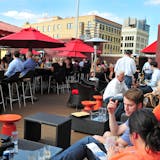Ramsey County leaders say the COVID-19 pandemic and ensuing financial fallout isn't stopping them from moving ahead with RiversEdge, the $788 million riverfront redevelopment proposed for downtown St. Paul that includes apartments, condos, retail, offices and a dramatic urban park.
But precisely what gets built — and when — could change as the pandemic affects demand for office space, hotel rooms and shopping. The first phase of the project now will likely be an apartment tower to meet the strong demand for new housing.
The state's stalled bonding bill is another complication. Ramsey County leaders are seeking $40 million in state funding to help pay for a portion of the massive project, designed to connect downtown with the Mississippi River.
"We are still committed 100 percent," said Commissioner Rafael Ortega, who represents downtown St. Paul. "Nothing has stopped from our side. Hopefully there is bonding this session. But we will continue making assessments and figure out what our next steps are."
The County Board will meet later this month with its developer, Los Angeles-based AECOM, to get an update on the project.
"I am still excited by and support RiversEdge. I am also looking forward to the update," said Commissioner Victoria Reinhardt in an e-mail.
The development plan presented at public meetings in 2018 and 2019 called for four high-rise towers built on the site of the former county jail and West Publishing Co. headquarters. A terraced concrete lid, to be built with taxpayer dollars, would turn the nearly 5-acre site into 10 acres and create outdoor public space connecting downtown to the river.
Original plans called for a 168-room hotel, 56 condos, 350 apartments, 30,000-square feet of retail, 1,600 parking spaces, nearly 1 million square feet of high-end office space and an urban park overlooking the river.


